Advertisements
Advertisements
प्रश्न
State Ohm’s law? How can it be verified experimentally? Does it hold good under all conditions? Comment.
उत्तर
Ohm's Law states that at constant temperature, potential difference across a conductor is directly proportional to the current passing through it.
Mathematically
V ∝ I
`"V"/"I" = "R"`
where,
V = potential difference
I = current
R = Constant of proportionality and it is called Resistance
Experimental verification of Ohm's law:
Material needed: a nichrome wire, an ammeter, a voltmeter, three cells, key etc.,
Procedure:
- Create a circuit as shown in the diagram, consisting of a nichrome wire XY of length, say 0.4 m, an ammeter, a voltmeter and three cells of 1 V each. Place all the equipment properly.
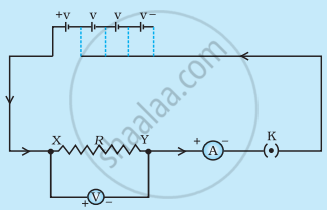
- First use only one cell as the source in the circuit. Note the reading in the ammeter I, for the current and reading of the voltmeter V for the potential difference across the nichrome wire XY in the circuit. Mark the corresponding readings in the Table given.
- Now connect two cells in the circuit and note the respective readings of the ammeter and voltmeter for the values of current through the nichrome wire and potential difference across the nichrome wire.
- Calculate the ratio of potential difference V to current I for each step.
Then plot the graph between potential difference and the current.
The graph between potential difference and the current is observed to be a straight line passing through origin. The slope of V-I graph indicates the resistance of the circuit. This verifies Ohm's law.S. No. Number of cells used in the circuit Current through the nichrome wire, I (ampere) Potential difference across the nichrome wire, V (volt) V/I
(volt/ampere)
1 1 2 2 3 3 4 4 
Ohm's law does not hold good under all conditions. It is obeyed by metallic conductors only when physical conditions like temperature etc. are kept unchanged and ideal. It is not obeyed by semiconductors, junction diode, thermistor etc. These are called non-ohmic conductors.
APPEARS IN
संबंधित प्रश्न
Write the formula of resistivity
Write the SI unit of resistivity
Calculate the effective resistance across AB?
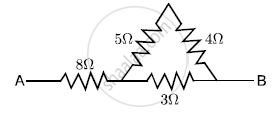
Two metallic spheres A and B kept on insulating stands are in contact with each other. A positively charged rod P is brought near the sphere A as shown in the figure. The two spheres are separated from each other, and the rod P is removed. What will be the nature of charges on spheres A and B?
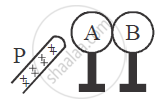
Fig. represents the circuit used for the verification of Ohm's law. Label the parts from A to F. state the function of each.
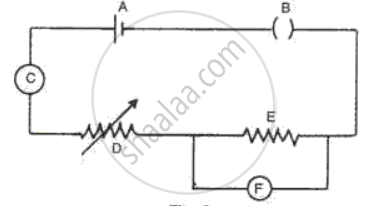
The unit of specific resistance is ____________.
The temperature of a conductor is increased. The graph best showing the variation of its resistance is:
You are provided with a resistor, a key, an ammeter, a voltmeter, four cells of 1.5 V each and few connecting wires. Using circuit components, draw a labelled circuit diagram to show the setup to study Ohm's law.
State the relationship between potential difference (V) across the resistor and the current (I) flowing through it. Also draw V-I graph, taking V on the X-axis.

Vinita and Ahmed demonstrated a circuit that operates the two headlights and the two sidelights of a car, in their school exhibition. Based on their demonstrated circuit, answer the following questions.
- State what happens when switch A is connected to:
a) Position 2
b) Position 3 - Find the potential difference across each lamp when lit.
- Calculate the current.
a) in each 12 Ω lamp when lit.
b) In each 4 Ω lamp when lit.
OR - Show, with calculations, which type of lamp, 4.0 Ω or 12 Ω, has the higher power.
The circuit depicted in the figure is employed for studying Ohm's Law. Instead of using a standard resistor, a student opts for a glass tube filled with mercury (tube 1), connected to the circuit through two electrodes E1 & E2. He records the readings of the ammeter and voltmeter, thereby calculating the resistance. The student repeats the experiment by substituting tube 1 with tube 2, where the same amount of mercury fills the tube 2.
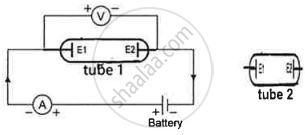
Neglecting internal resistance of the cell use (> or < or =) to compare
- the resistance in both the cases.
- the voltmeter readings in both the cases.
- the specific resistance in both the cases.
